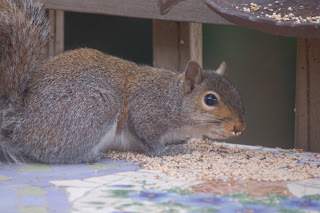 Wildlife Hotline Questions
Wildlife Hotline QuestionsDuring the next few weeks, I'll be posting the types of questions we handle on Wildlife Rehab Inc.'s hotline. Watch for the answers!
Question 1: A squirrel moved into a hole in the outside wall of my house and is trying to gnaw into the drywall inside the house. How can I get him to move out?

13 Comments:
Hire a contractor, an expensive one if your siding is asbestos, have him totally tear down the outside wall of the house. Evict squirrel. I really don't know, but please let us know. Maybe some smoke would do it.
There's a much easier, more effective solution, which I'll post later this evening, along with a video!
Put a radio in the hole. Turn the music up LOUD.
Loud music could make matters worse because it will stress the squirrel, which will probably translate into more stress and trouble for humans, especially if she leaves her babies behind.
The best solutions are the ones with good outcomes for animals and people.
OK, here we go.
There are several ways to encourage a squirrel to move on.
During breeding season -- between February and September in North Carolina -- I would hire a humane wildlife control company to make sure both mom and babies get safely to their backup nest. A humane wildlife company will remove the babies and put them in a basket where mom can get to them and safely move them. The company then seals up the entry point. Check out this video from Gates Wildlife, a humane solutions company based in Canada: http://www.youtube.com/watch?v=fk-IN9nTD8g
There are several considerations in choosing a company. Among them:
1. Make sure they focus on long-term solutions by sealing entry points.
2. Make sure they have a commitment to reuniting babies and mothers.
3. Make sure they frequently monitor for the presence of babies.
4. If they use a live trap, it should be monitored several times a day or the animal could die due to stress.
5. Make sure they guarantee their work.
Relocating an animal to another location isn't a good solution. The animal is likely to die in unfamiliar territory. And the removal of an animal creates a vacancy for another animal (perhaps even more!) to move in, so the cycle continues.
During non-breeding season, you can encourage squirrels to leave by leaving on a light or a radio tuned to a talk show -- rather than loud music.
One way to determine if the squirrel has left is to loosely tape a piece of paper over the hole or to ball up a piece of paper and loosely stuff it in the hole. Leave it in place for 72 hours. If it hasn't been disturbed during that time, the hole probably hasn't been used. In spring and summer, it's crucial to check for babies before sealing any openings.
Yes, but HOW do they get the babies out of the wall without destroying part of the wall?
They use a special "snake" camera that can poke around corners to find babies. The technicians have the experience and know-how to extract them. I wouldn't recommend trying this yourself. Mother squirrels will protect their young.
And yes, they may have to cut a section of the wall to remove the babies, but shouldn't have to tear down a whole wall.
I don't intend on trying it myself, and do not have a squirrel problem here, but you have really piqued my curiosity and now I dying to know, how do they extract them?
Were you able to view the video?
Gates Wildlife Control has posted several videos on YouTube showing how they remove squirrels and raccoons and reunite them with their mothers. The technicians wear protective clothing and gloves before handling the animals. Handling wildlife can be hazardous. That's why I suggest getting professionals.
They can locate where in the wall (or ceiling or wherever) the babies are. Some will use a listening device to find them. Cutting open only that portion where the babies are, they remove them. The mom leaves due to the commotion. They seal up and replace that portion they removed and place the babies in a heated container near where the mother gained access. She returns to move the babies, one by one when she hears them crying that shrill pitch they make.
Yes, they can pinpoint the location of babies in the wall. Thank you for clarifying that.
Even more important, why bombard our animal friends with chemicals if they don't need them? As a veterinarian who practices natural medicine, I believe that less of anything is almost always better. Zookeepers also often speak to both media and the public in an effort to educate about issues related to the zoo they work for. Video on Using a Microscope. Easy to use, high definition digital video microscope system. That said, there's nothing here that's too kind to Michael Jackson in light of the scrutiny he was facing at the time.
Post a Comment
<< Home